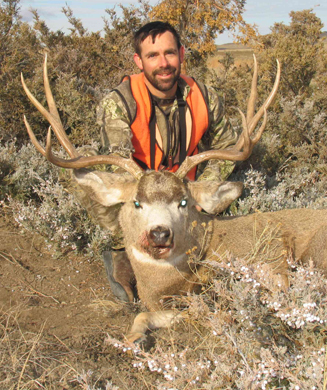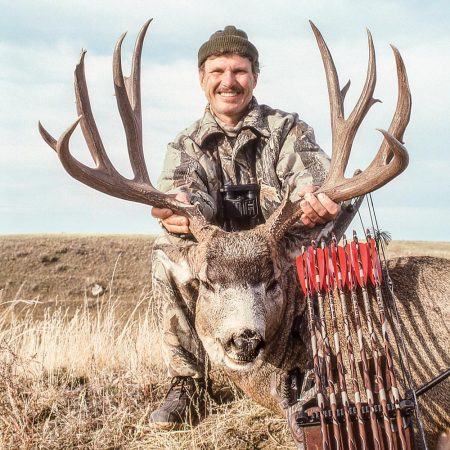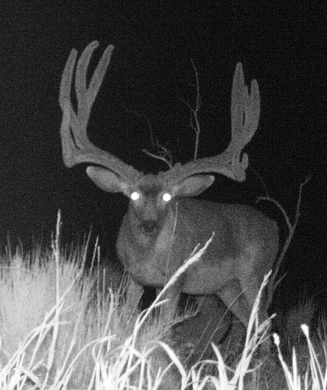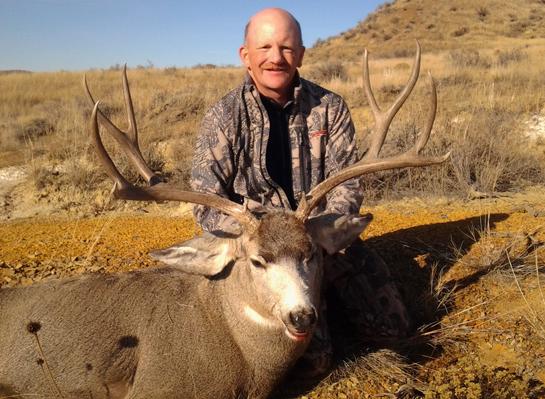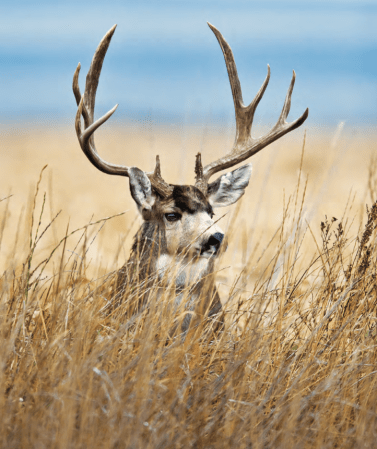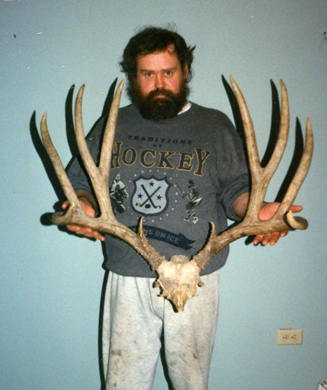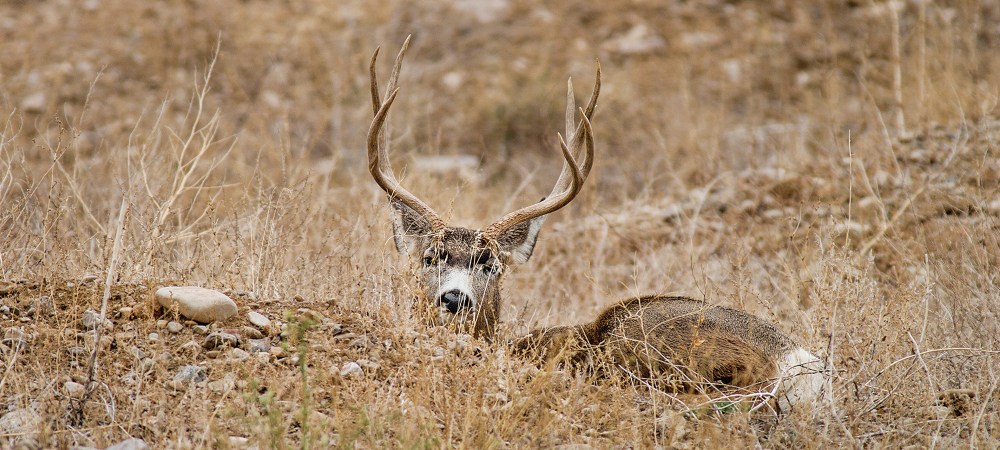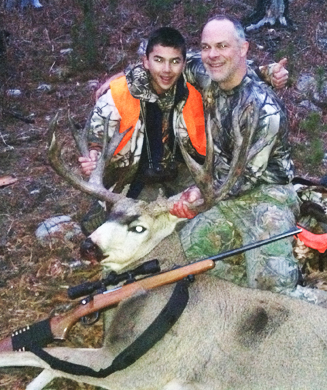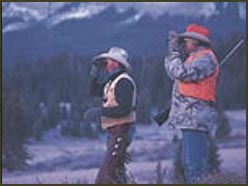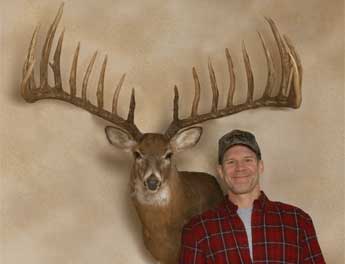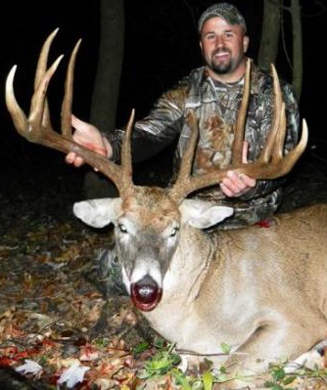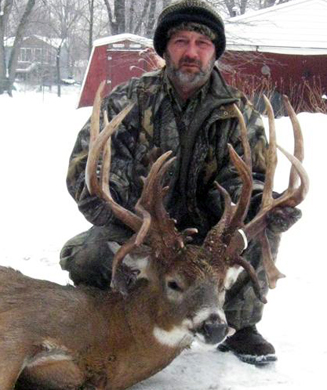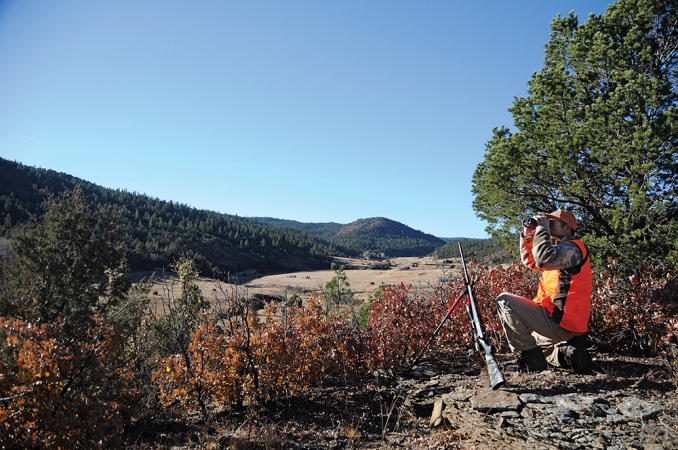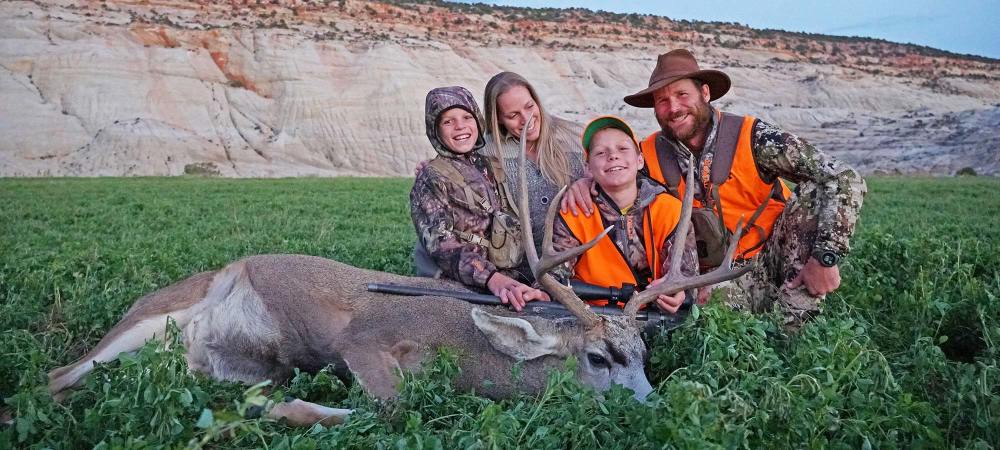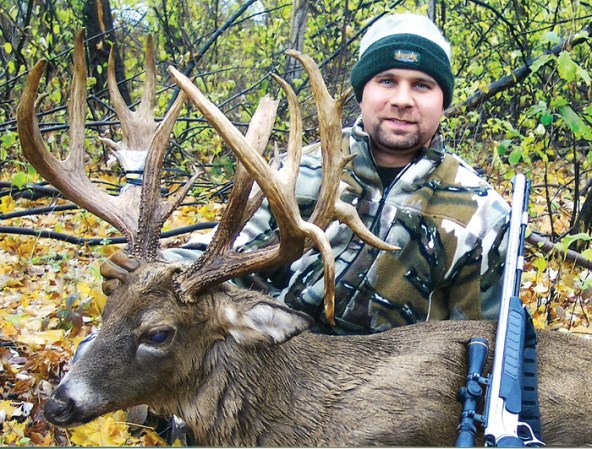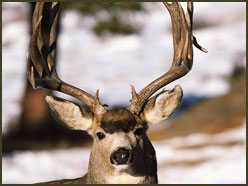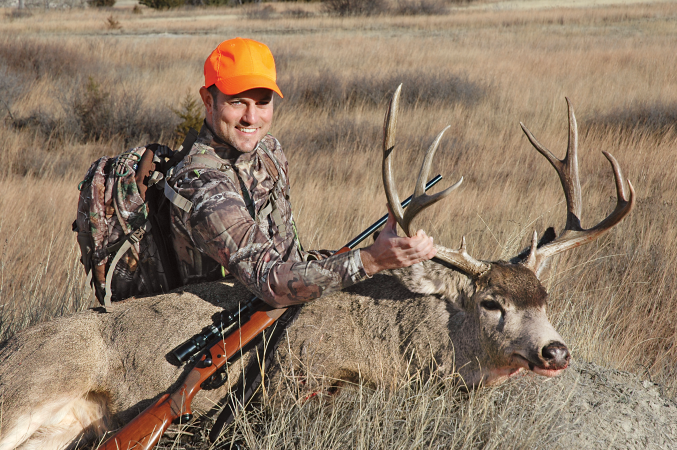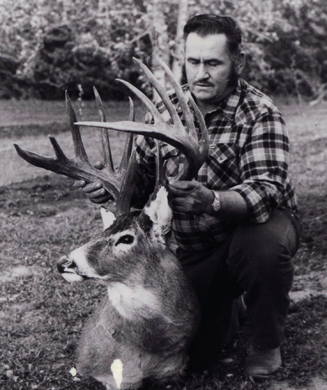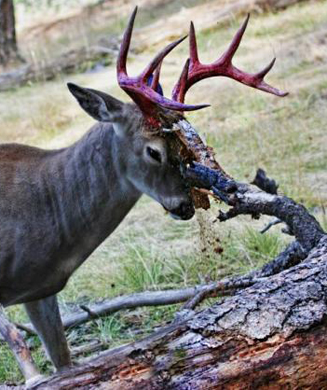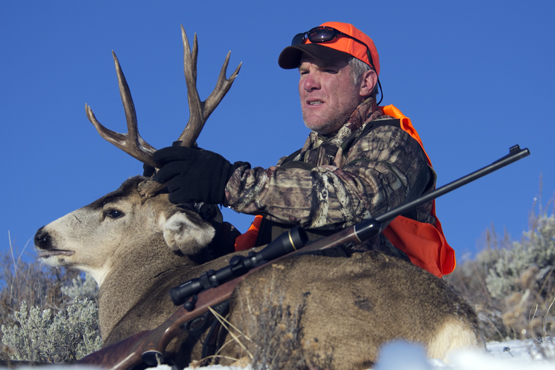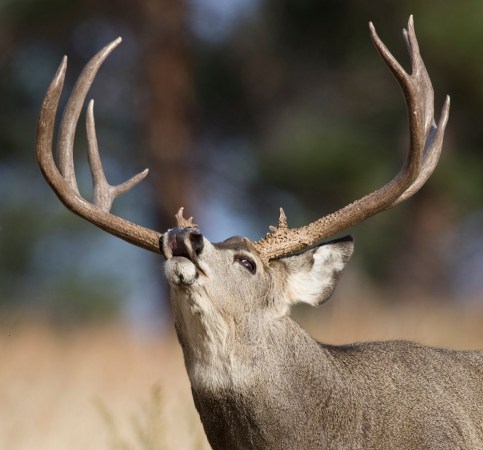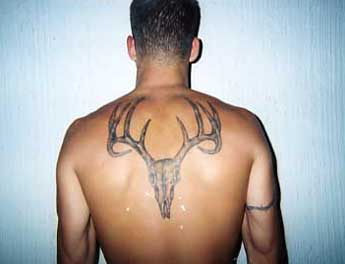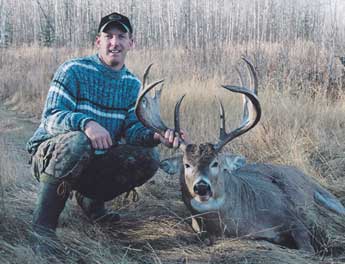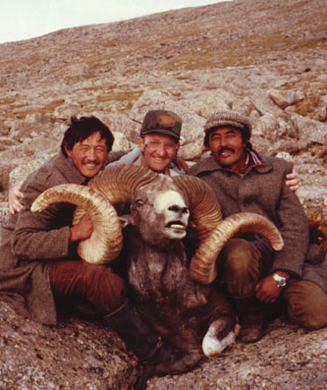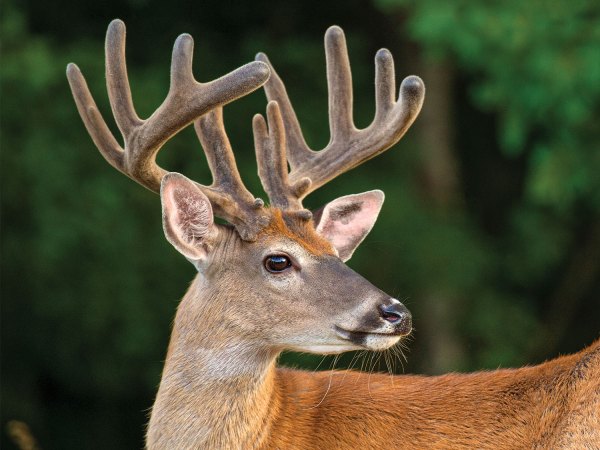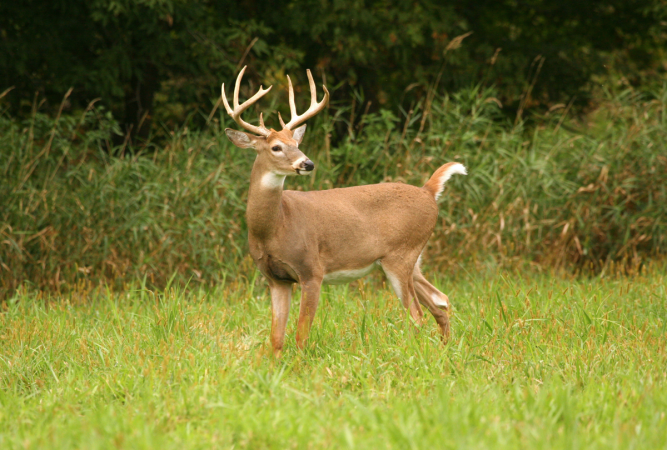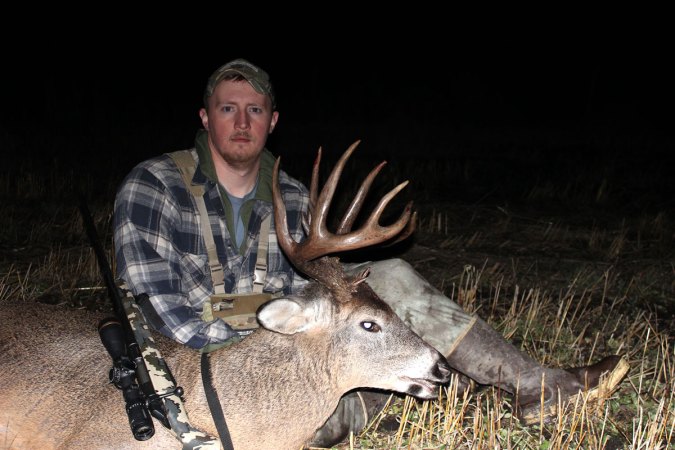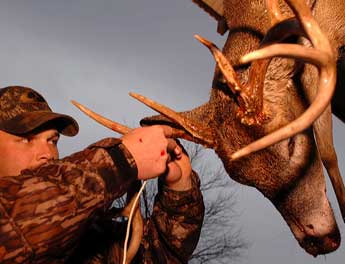Here are two remarkable bucks. That's me on the right, with a tall-tined Wyoming muley. It's my buddy Jon LaCorte, who handles Nikon's marketing and press business, on the left. This photo, and this hunt in southeastern Wyoming, is instructive for a couple of reasons. First, I'm hung up on wide mule deer, and for the longest time I was sure LaCorte had killed the better buck. But I finally measured my deer, years after I killed it, and its high tines and crazy-deep forks give it the better score. It's not a whopper–it scores 186–but his bladed tines and fairly heavy antlers give it a better score than I expected. Incidentally, that's Jon's first mule deer. Not bad for a beginning buck, huh?
This is one of the smaller mule deer I've ever killed, but even though this buck never knew I was hunting him, he wouldn't stop moving. I was hunting in Wyoming's North Platte River country, and I wasn't being picky. I spotted this buck, along with two or three other of his class, in the middle of the afternoon feeding in a dry wash. I made a sneak to within 400 yards, but the bucks wouldn't stop. They kept feeding and walking at a pace slightly faster than my fast walking pace. I followed, got in position again, but again they wouldn't stop. I finally shot this buck at 480 yards with my .257 Weatherby Magnum about two miles from where I first spotted him. Interestingly enough, I questioned whether this deer had chronic wasting disease. I was hunting in an area with the deer disease, and later saw an emaciated buck obviously suffering from the end stages of CWD. My buck kept shaking his head as I pursued him, and while he never seemed disoriented, he wasn't in great physical shape. I had his brain tissue tested for CWD, and the diagnosis said he was free of CWD.
Every time I look at this Utah mule deer I recall another buck from this hunt. I was elk and deer hunting in the northeastern part of the state in September. I was being pretty particular, and passed a huge 3×4 because, well, because he had only 3 points on one side. Stupid choice, in retrospect. Then I saw the largest deer I've ever seen on the hoof, and my decision to pass on the non-typical seemed justified. This epic mule deer probably went 33 inches wide, was deeply forked, and still in his velvet. He was feeding away at about 800 yards with a couple of junior bucks, and I felt good about the stalk. But when I got to where he had been, he had vanished. I hunted for that buck for the next three days. On the third day, literally moments before I was set to leave the hunt, this buck jumped out of the sagebrush and sprinted past me at about 30 yards. It was more of a wingshot than precision shooting, but I dumped the buck in this aspen grove. I love his luxurious velvet antlers, but I sure wish I had seen that monster buck again.
This is a photo of a deer I didn't kill. I was hunting the high buck hunt in Washington's Cascades Range, a hunt I used to love to make, even though I rarely saw more than a handful of deer in the alpine meadows. It was more like an armed backpacking trip than hunting. I had just settled down beneath this tree to glass a distant meadow when I heard a snap and looked up. This buck was looking around the tree at me. I managed to snap this photo, but by the time I got my rifle up, he had bounded into cover and was gone. The Cascades Range split the distribution between blacktailed deer to the west and mule deer to the east. I think this is a blacktail, and a pretty good one at that.
This eastern Montana buck is a strange one. His antlers have characteristics of both whitetails and mule deer, but what was really odd about him is that his testicles were totally metastasized, and his rack is so thin and brittle that he's almost like a hard-horned stag. But what this hunt, on my own property on the very last day of the season, showed me is how tough mature mule deer can be. I spotted this deer among a herd of maybe 20 does on a cold, snowy afternoon and made what appeared to be a good shot at 350 yards with my .300 Remington Ultra Mag. I never heard the "whock" of the bullet, but something about the way the deer jumped told me that I had hit him. He ran, but then stopped at about 800 yards and started feeding again. I figured I'd better look for blood, and when I approached the whole herd ran, including this deer. Sure enough, I found specks of blood, but then they stopped, and his tracks mingled with all the others. I followed the tracks for a spell, then found another drop of blood on the snow. To make a very long (3-hours-long) story shorter, I tracked that buck about two miles over hip-deep snow, finding increasingly big blood sign. He climbed big ridges and bombed down snow-filled coulees, and I could see where he had stopped to watch is backtrail. I finally killed him in a little patch of berries where he hoped to remain hidden. One tough buck, especially when I discovered that his entire kidneys and most of his stomach was gone. Yes, I had hit him too far back.
This is last season's buck, shot on my property in eastern Montana. I hadn't intended to kill this deer–I had seen him a few times, the wad of orange baling twine wrapped around his antlers was pretty distinctive. But I took my daughter out hunting one day, and let her use my binocular. Iris spotted this buck at about 1,300 yards away, and looked up and said, "Daddy, there's a deer with orange antlers! Can we hunt it?" We waited for him to bed down with a pair of does, then made an epic stalk on our knees through sagebrush, along a frozen creek, and then belly-crawled across a gumbo flat. I gave Iris my bleat can and told her to make noise. She did, and when the does stood up, so did the buck. I dropped him, and Iris had her orange antlers.
I love this photo for a couple of reasons. First, this is an eastern Montana buck that looks like a Sonoran 35-incher. It's a trick of photography, of course. I'm sitting pretty far back, and the wide-angle lens exaggerates the antlers. But this was a nice deer, shot in the Missouri River Breaks in the very height of the rut's chase phase. This buck was tending a whole passel of does and was more or less oblivious. Notice his lack of brow tines. In two dozen or more bucks, I've never shot a mule deer with more than nubs for brow tines.
Every time I look at this photo, I kick myself. I passed this deer, figuring that I'd shoot something bigger. I was hunting the shoreline of Fort Peck Reservoir in eastern Montana, a hunting strategy that can be effective when the wind isn't raging on the big body of water. But it's hard hunting because you rarely get a good luck at deer. Every try glassing off a rocking boat? It's like bench-rest shooting off an aircraft carrier. I saw this buck headed for some cover about 1,200 yards away. I could tell he was a decent buck, but I didn't see all his trash and secondary points and told my buddy he should chase that deer while I went to look in another drainage. He came back with this buck, and I returned with a little 4-point that I didn't even photograph. This buck, with all his trash, scores right at 200 inches.
You can't tell much from this photo, but it's about 10 below when I took it. That's one reason I'm not in the frame. It was too cold to get the self-timer set up. I was hunting in really nasty badland country when I spotted this deer, bedded all alone in the side of a gumbo wash. He was tucked out of the wind, and all I could tell was that he was really wide and pretty heavy. And that his antlers were especially dark for an eastern Montana prairie deer. After I killed him, I realized he was also huge–field dressing in the 300-pound range. He was also ancient, probably 8 years old. I never measured this buck, but even with his broken tine he probably scored in the 170-inch range.
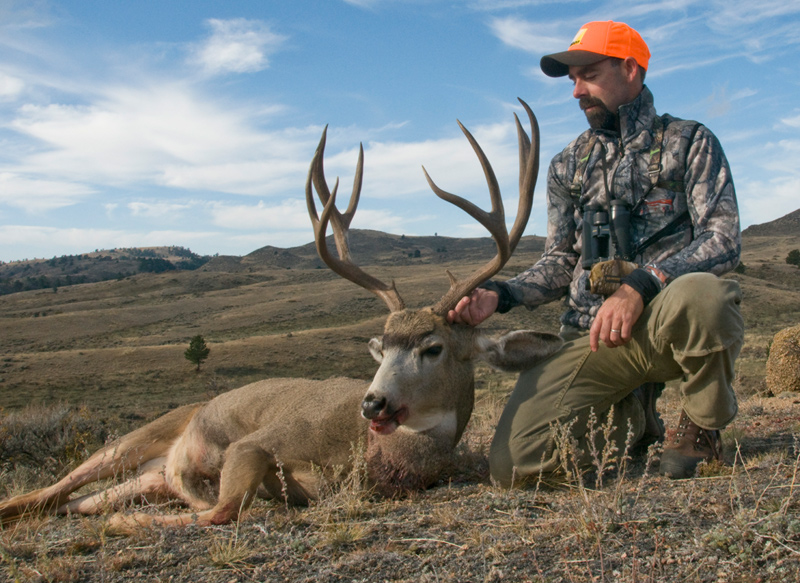
This is the only mule deer I've shot with a "modern sporting rifle," an AR. I used a Remington R-15 in .308 and killed this buck with a single shot at about 200 yards. I love this photo – it shows the country where he lived, and shows off his high, bladed tines. He ended up being a better buck than I initially thought, because of those deep forks and bladed back tines.
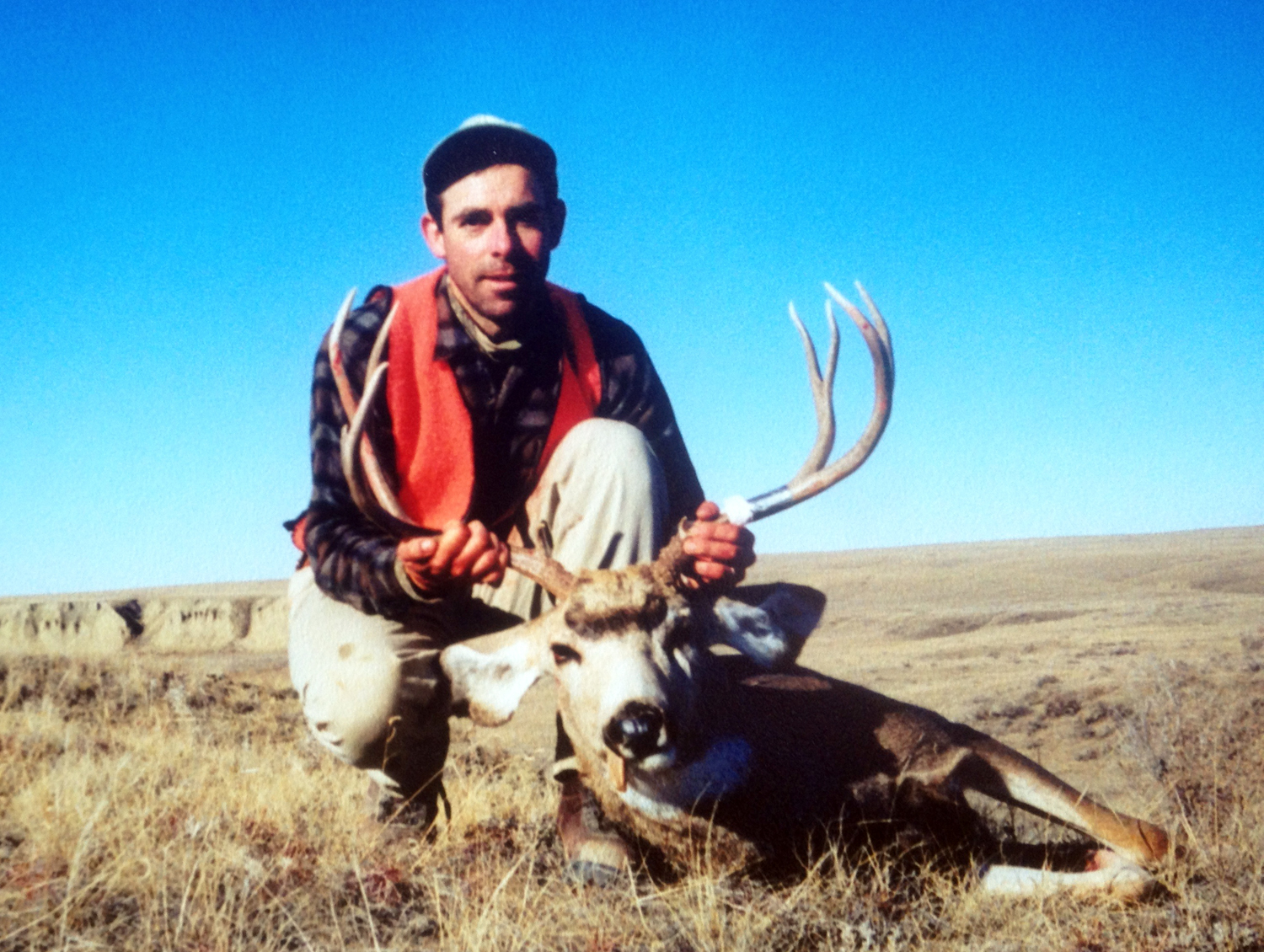
This is the first larger buck I ever shot. I think it was 1996, maybe a year or two earlier, and I was hunting BLM ground in north-central Montana not far from the Canadian border. I was basically just prospecting for deer, walking miles along a dry wash, when I spotted a herd of mule deer bedded on a sidehill, soaking up the November sun. I belly-crawled closer, and started glassing the herd. A bunch of does, a forkhorn buck, more does. But I knew it was the rut season, and there had to be a buck somewhere. Finally, I spotted him, bedded in a scoured out ledge in a dirt cutbank above his harem. That strategy, finding a herd of does, then picking apart the landscape until I find a bedded buck, has paid off many times since, but this was the first. I shot him in his bed at about 250 yards. His antlers are thin and willowy, like so many of our prairie deer. But this buck will always be special to me. He was one of the first that helped me unlock mule deer behavior.
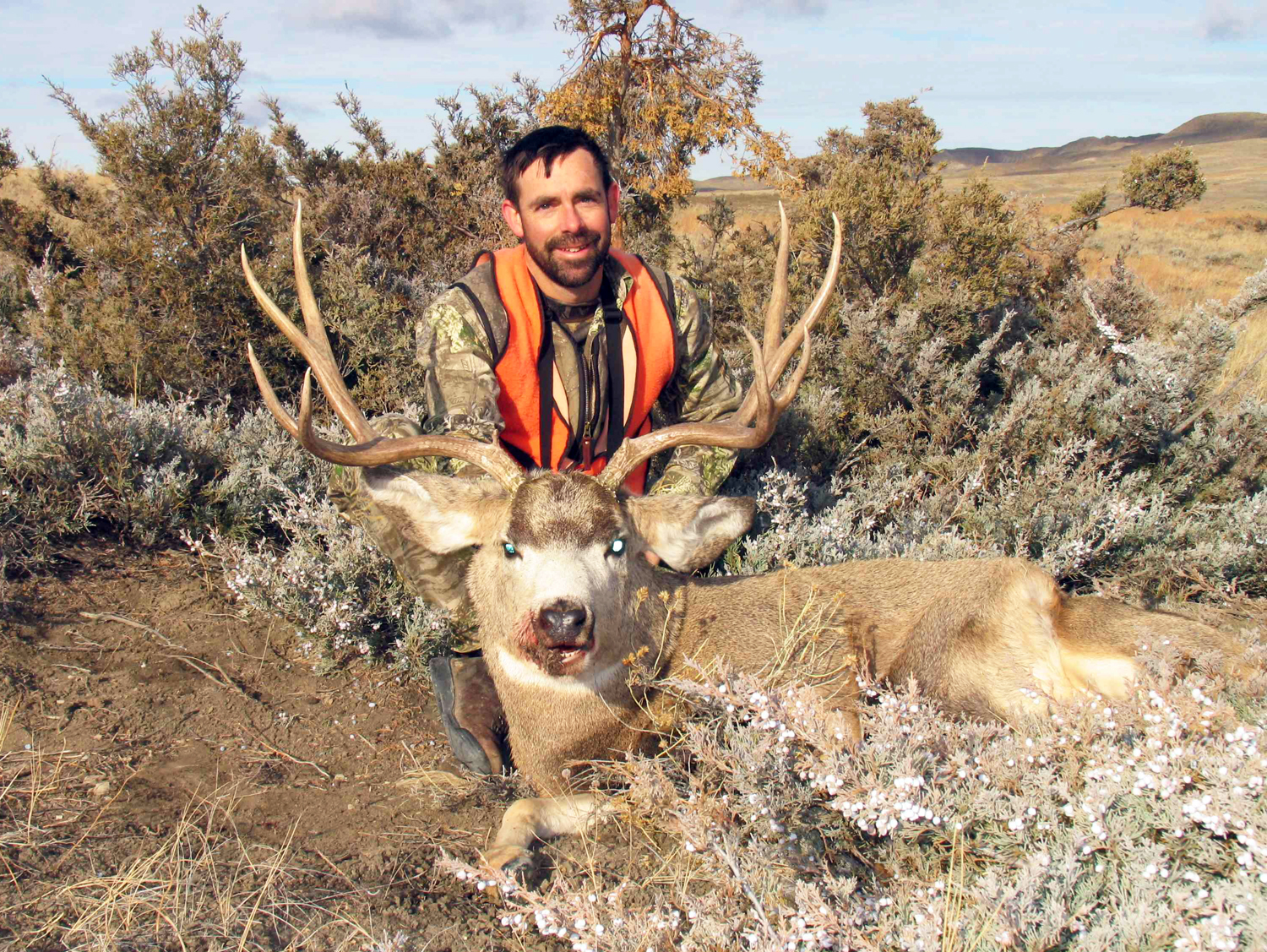
My best buck to date, and the only 30-incher I've ever shot. The story of this deer is pretty cool, too. I was hunting the Missouri River Breaks of eastern Montana with my buddy Mark Copenhaver, who is just as spun out with big mule deer as I am. We had driven to the border of the Charles M. Russell Wildlife Refuge, which had closed to mule deer hunting a few days prior to our trip. Still, we figured we'd hunt the open area outside the refuge, and while Mark was taking a leak, I started glassing a sagebrush drainage. The sun was just coming up, and glinted off this buck's rack. Even at about two miles away, I could tell he was worth hunting. Mark joined me, and I showed him the deer. "Let's go kill him," I said confidently. You know how that goes. After dropping into the dry wash, then belly-crawling across sagebrush, we popped out, but the deer was gone. So I went one way and Mark the other, figuring that we'd cover more ground that way. I finally spotted this buck. He was slinking toward the refuge boundary, almost on his belly, the way a high-pressured whitetail will slip through cover. He had abandoned his harem and was closing in on the refuge fence when I anchored him. I've never measured this buck, but with his thin antlers and super-wide spread–and no brow tines!–I'm sure the score would disappoint me. Sometimes, it's better to enjoy the trophy for the hunt rather than the score.
Record Quest host Andrew McKean has learned a lot throughout his mule deer hunting career. These are the bucks that educated him.

